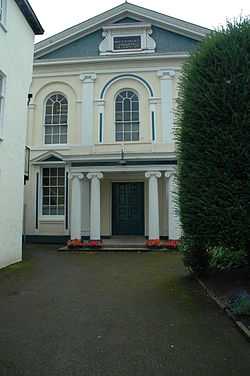Monmouth Methodist Church
| Monmouth Methodist Church | |
|---|---|
 | |
| 51°48′45″N 2°42′42″W / 51.8126°N 2.7117°WCoordinates: 51°48′45″N 2°42′42″W / 51.8126°N 2.7117°W | |
| OS grid reference | SO 5094 1295 |
| Location | St James Street, Monmouth, Monmouthshire NP25 3DL |
| Country | Wales |
| Denomination | Methodist |
| Website |
monmouthmethodist |
| Architecture | |
| Heritage designation | Grade II* listed |
| Architect(s) | George Vaughan Maddox |
| Style | neoclassical |
| Clergy | |
| Minister(s) | Rev Barry Smith |
Monmouth Methodist Church is located in Monmouth, south east Wales. It is set well back from St James Street between buildings. Designed by George Vaughan Maddox and built in 1837, it retains its original galleries, organ loft and sophisticated pulpit.[1]
In common with many non-conformist places of worship in the town built when town authority lay very much with the established church, it was deliberately set back behind the houses to avoid making too prominent a challenge to the established order. This is one of 24 buildings on the Monmouth Heritage Trail and is Grade II* listed.[2]
History
In the eighteenth century the new Methodists were challenging the presumption of the established churches in Monmouth. Visiting Methodist ministers were stoned and abused by unruly crowds who were encouraged by the churchwardens and gentlefolk.[3] They were sometimes seriously injured – a preacher was killed by a blow in an open-air service near Hay-on-Wye in 1840. They persevered however and established their first chapel in Inch Lane, now called Bell Lane, a narrow alley off Church Street. John Wesley came to preach in the town, firstly in 1779, and four more times in later years, and a larger chapel was built in Weirhead Street as Wesleyan Methodism grew.
Finally, as this chapel proved too small, the present church was designed by George Vaughan Maddox, a local architect who had worked on The Hendre.[4] The 340 seated church with its impressive façade was built in 1837.[5] Maddox included Ionic pilasters with round-headed Georgian windows on the first floor but with triangular window heads on the ground floor, and a fine pediment over all. The church is enhanced by the later Ionic porch. The box pews allow 340 worshippers in sit in three sections below and in a gallery that follows three sides of the interior. The pulpit was much higher than it appears to day as not only was the pulpit lowered in 1885 but the floor was also raised by two feet. Because of this the columns inside the church lack bases as they are covered by the raised floor.

The Reverend Peter Mackenzie was employed as preacher and he drew a large following; he had a personal relationship with many Methodists, whilst his sermons were filled with "grotesque descriptions and extremely funny stories".[6] Mackenzie arrived from Burnley, Lancashire, and lived at Coleford with his wife and two children using a donkey to travel around the circuit. A lady visitor, Mrs Bullock, commented whilst waiting for the minister to arrive for the service that she would buy an organ if ever the church was full. The minister arrived and immediately the church had reached its capacity. True to her word an organ was purchased and installed in celebration of this achievement.[6] This church is considered to be one of the most architecturally distinguished Methodist chapels in South Wales with an interior that reflects its purpose and design. According to the local Pevsner architectural guide:[7] "The interior, quite exceptionally for an early C19 chapel, is a coherent piece of considered architecture." The church as a whole is described as "a most satisfying work."[7]
The "Queen's Head" public house on the opposite side of St James' Street is owned by the community.[8] The timber frame dates from 1920 but the public house was built in 1630. This building has undergone many changes to its frontage since it was built around 1630 and a 17th-century plaster ceiling is extant in the building's bar.
The church today
The church has morning and evening services every week with a family service every month.[9] The Monmouth church is part of the Newport and Lower Wye Circuit that includes other Methodist churches at Trellech, Broadoak, Llancloudy and Gworn y Saint.[10]
References
- ↑ "Monmouth Methodist Church". Retrieved 10 January 2012.
- ↑ "Wesleyan Methodist Chapel - Monmouth - Monmouthshire - Wales". British Listed Buildings. Retrieved 2013-10-04.
- ↑ Bold, Rev. W. E. (1987), Methodism and its Beginnings in Monmouth, Monmouth Methodist Church
- ↑ "The History of The Rolls at Monmouth Golf Club". Rolls Golf Club. Retrieved 17 January 2012.
- ↑ Newman, John (2000) The Buildings of Wales: Gwent/Monmouthshire. Penguin Books ISBN 0-14-071053-1
- ↑ 6.0 6.1 Dawson, Joseph (1896). Peter Mackenzie, his life and labours (esp. p. 141).
- ↑ 7.0 7.1 John Newman, The Buildings of Wales: Gwent/Monmouthshire, Penguin Books, 2000, ISBN 0-14-071053-1, p. 399
- ↑ Queen's Head, queensheadmonmouth.co.uk, accessed 17 January 2012
- ↑ "Monmouth Town Guide". Monmouth Town Council. Retrieved 10 December 2011.
- ↑ "The Messenger" (PDF). Oct–Nov 2011.
External links
| Wikimedia Commons has media related to Monmouth Methodist Church. |